to the index page
There were 3500 photos from our two cameras, and I chose the best 10% to post on this site. That still seemed like a lot so I selected the best 1% and arranged them here so you'll understand how it was at a glance. Then you can peruse the whole photo story here:
page 1; page 2; page 3; page 4; page 5;
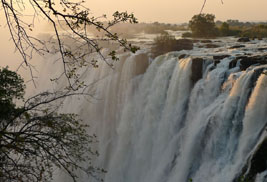
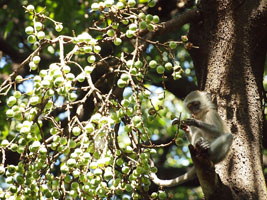
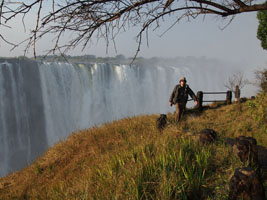
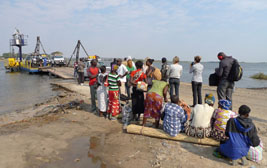
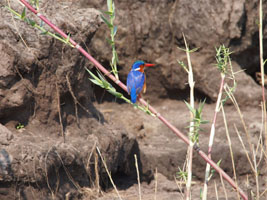
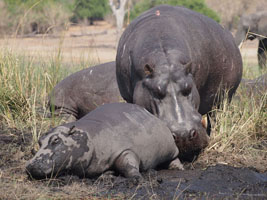
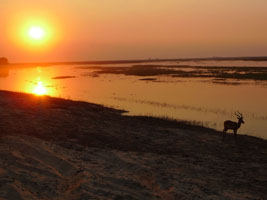
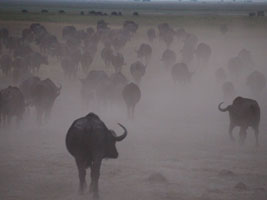
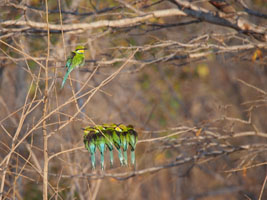
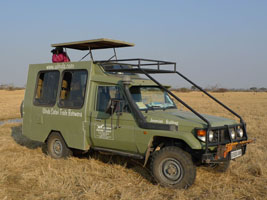
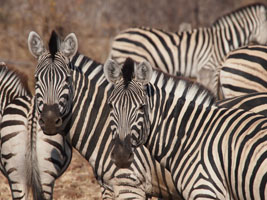
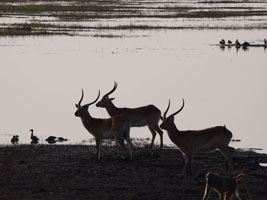
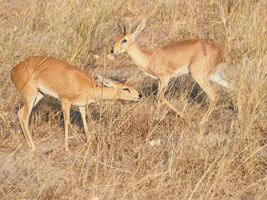
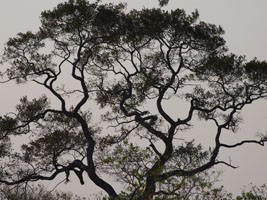
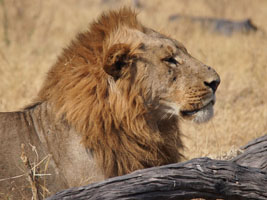
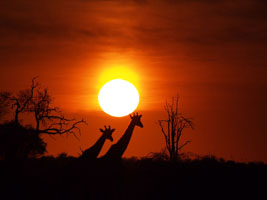
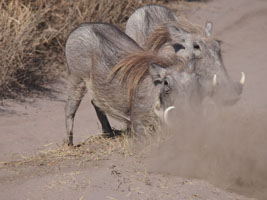
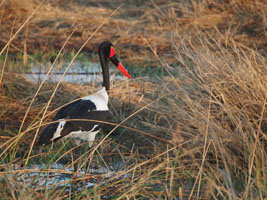
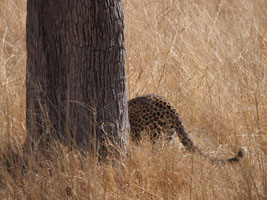
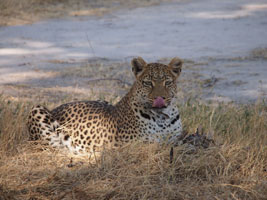
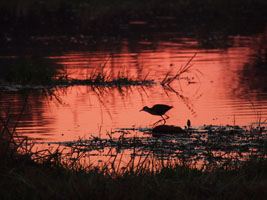
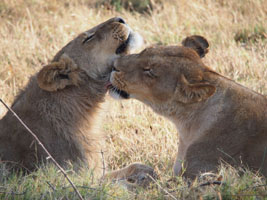
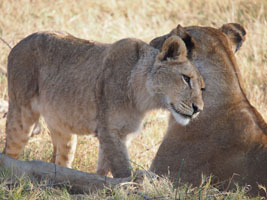
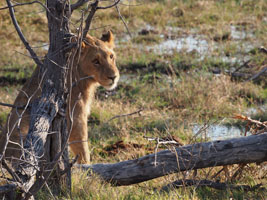
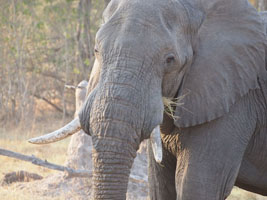
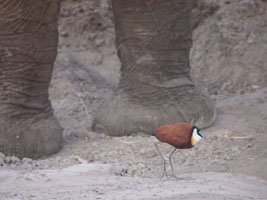
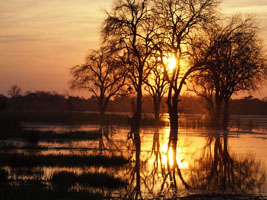
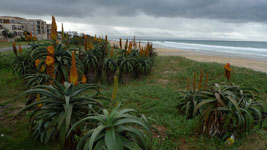
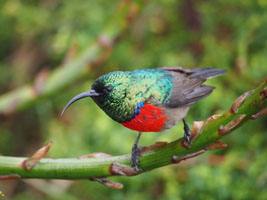
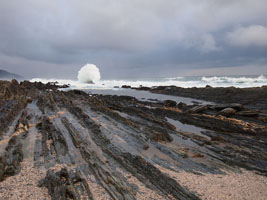
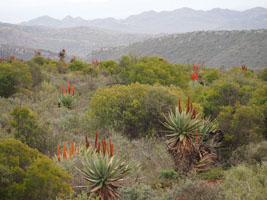
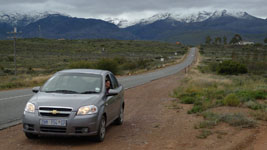
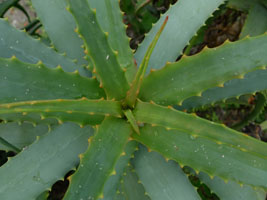
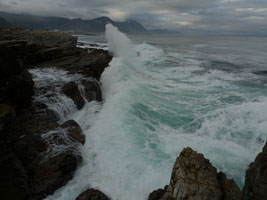
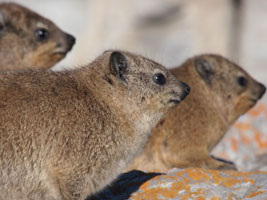
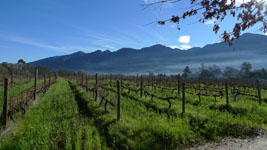
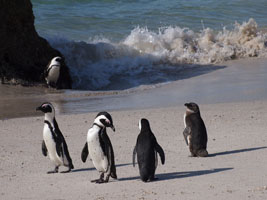
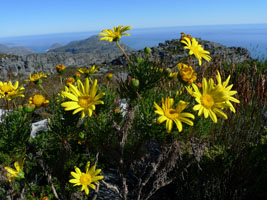
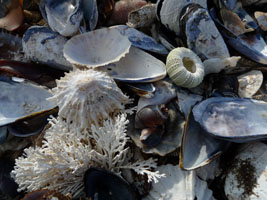
Fast connection? Have time? Go see the whole photo story here:
page 1; page 2; page 3; page 4; page 5;
Joy and I are back home after three weeks traveling in southern Africa - on safari in Botswana, and then driving the south coast to Cape Town; also, a short visit to Zambia and Zimbabwe at Victoria Falls, the big waterfall on the Zambezi River. One can't get much farther from San Francisco without leaving Earth, and it took us 26 hours of flying, not counting layovers, to get home via Singapore and Seoul. The safari was a mobile camping outfit with a guide, two camp staff, and private sites in the parks of northern Botswana where the land is cold, parched, and dry but water rushing in from rains upriver earlier this year has filled the swamps and channels, bringing the animals together at the water. We slept in tents in the bush for 8 nights, moving camp several times, spent mornings and evenings riding around in our guide Jane's land cruiser looking for animals, relaxed in camp and dined on excellent food prepared by our staff Victor and Hassie, and sat around the campfire at night admiring the galaxy sparkling across the crystal clear sky. We saw many kinds of antelope and buck, zebra, giraffe, colorful birds, dogs and cats big and small, hippos, crocodiles, and hundreds of elephants. The best part of all this was not knowing what we might come upon - a hunt, perhaps, or a new animal. Even just sitting still somewhere, we would be occupied for hours watching the scene before us. The concentration of animals at this time of year seems unreal. It also was a bit alarming to see how destructive the animals, especially elephants, are to forests and vegetation in general, and to realize that people today cannot really live among the animals. Agriculture is impossible; it is an interesting situation. Perhaps I'll write more about that later. By our ninth day in the bush we were ready for something new, and upon arriving in Johannesburg we got a luxury room at an upmarket hotel (all with club points!), ordered in-room dining, and thoroughly enjoyed the abundant water, silky sheets, and complete absence of sand. The next day we took another flight to the south coast and rented a car in a heavy rainstorm that continued for days as we drove across a wonderfully diverse landscape arriving in Cape Town five days later. There was lush forest of strange plants, desert scrubland like Utah but with ostriches running around, endless fields of emerald green wheat, a beachside town on a deep blue bay where we saw whales just 100 meters from shore and a furry pile of dassies, aka rock hyrax, a strange creature that looks like a groundhog, has hooves, and is more closely related to elephants than other cute furry rodents. We tasted South Africa's wines, admired the vineyards, slept in a thatched roof round-house (a really nice one), ate the finest cuisine, took the cableway to the top of Table Mountain, watched penguins on the beach, and met some interesting people.
And now for the story in its entirety!
Megafauna once roamed all the earth, they say; big cats hunted the great herds and woolly elephants ravaged the fields and forests. Where the grass was good, animals came by the thousands and no place was quiet at night for all the shuffling hooves, grunting, trumpeting, and occasional screams of death. Then things changed in most of the lovely temperate lands of Europe and Asia and the Americas: the great beasts disappeared, fences went up around neat farm fields, and lurking in the shadows there was little more than birds and foxes. But one place stayed wild: the grasslands of eastern and southern Africa.
Then along came big agriculture, motor vehicles, and wire fences, and most of these lands too fell silent. Only in the parks does the earth still look like it has for eons, a rich scene of animals ranging across the grassy flats and forests undisturbed by modern technology. Especially in the dry season when water is scarce these creatures of prehistory become concentrated together in such numbers and diversity that one realizes the old stories are true: game really did stretch to the horizon, and with an intensity far greater than anything we know today, each day the setting sun unleashed both danger and opportunity.
I learned this in Botswana. The stars overhead were brilliant in the cold night sky, before the moon rose, and all around my haven of canvas tents and glowing coals I heard rustling, thumping, bleating, chirping, and sometimes, the deep rumbling call of a big carnivore. Joy and I were traveling with a safari outfit called Ulinda Safari Trails, just the two of us and our guide Jane Bettenay, with her staff Victor and Hassie along to set up camp, cook meals, serve tea, build the fire, and keep watch at camp while we went out driving mornings and evenings.
For eight days we did this, moving camp twice and covering a swath of north Botswana from the border with Zambia across through Chobe, Savuti, and the Khwai concession along the edge of the Moremi game reserve in the Okavango Delta. It was fantastic, relaxing, exciting, and quite comfortable for a camping trip. When it was all over Joy and I flew to the south coast and drove to Cape Town, taking another week to see a completely different part of southern Africa where there were green fields, stormy beaches, snowy mountains, penguins, whales, vineyards, ostrich ranches, and upmarket European style shops and dining. Between this, the safari, and a couple days in Zambia and Zimbabwe at the start of the trip exploring Victoria Falls, we were traveling for three weeks.
One can't get much farther from San Francisco without leaving Earth, when in the far south of Africa. It took us days, literally, to get there flying a reasonably direct route through Seoul and Singapore. Part-way through our travels I had a distinct feeling that I was getting closer to home rather than farther away, which was actually true relative to my original home on the US East Coast. Even from the West Coast, traveling via Europe would have been slightly shorter but the timing didn't work out for our frequent-flyer ticket options so we chose the Pacific route on Singapore Airlines. There was a greater diversity of passengers on the Singapore to Johannesburg flight than I have ever seen on a single aircraft: people of European, Asian, Indian, and African descent and many more of heritage not immediately apparent were all traveling together.
Once our last flight had landed on a small airstrip in Zambia, we walked down stairs to the tarmac and across through some trees to the little terminal building. On the other side, past the basic formalities of entry and a chaotic distribution of bags brought from the plane in a pickup truck, a driver brought us across town to one of the popular backpacker hostels.
After enjoying hot showers and putting on clean clothes, we went outside. I changed some US dollars to kwatcha at a shop nearby and with this we paid for our room and bought some food and water at the supermarket across the street. Having seen a sign at the hostel pointing in the direction of the communal kitchen, we decided to buy a sausage, some pasta and sauce, and a package of green stir-fry vegetables rather than go out to eat. Barbecue, or braai as they call it in South Africa, is very popular in the region and the boerwors sausages they make are both common and tasty-looking so I was interested to try some right away. Seasoned with coriander, cloves, and thyme, they ended up being a little different than I would have liked. The fresh produce in the market looked fabulous, fresh and colorful and better than what we usually see at big grocery stores in the US! There was a long line of people buying bread freshly pulled from the oven. It smelled wonderful.
The kitchen had very poor equipment, as it turned out. The only knife was just a broken-off blade without a handle, with the edge gouged on some sort of grinding wheel in an attempt to sharpen it. Some of the pots had no handles and the small electric stove was covered thickly with blackened grease. We had to put a cash deposit at the front desk to obtain bowls, spoons, and a couple of better pots. I thought of all the decent kitchenware for sale at the store where we bought groceries but made do with what we had. There was plenty of food, and it was a decent meal. Two black tabby cats sat beside our table outside acting cute and eating the pieces of sausage this earned them.
The sun was getting low by this time so we hailed a taxi and rode ten minutes to Victoria Falls intending to stay for a few hours and see the lunar rainbow visible for a few days around the full moon. On the Zambia side a new park entrance and visitor center was being built so there was almost no infrastructure, just some chain link fences and a ticket sales shack. Out taxi driver insisted that he set a time to meet us for the return trip, which we agreed to on learning that the road gets very few cars passing after dark. I would rather have not been held to a schedule, but it was good to have a ride at an agreed price already arranged.
Earlier as our flight came in to land I saw the river from the air, and the place where mist rose from the hundred-meter-deep gorge below the falls. The July landscape is desiccated brown as far as the eye can see, except for a fringe of green along the meandering, braided channel shining cobalt blue in the sun. Now for the first time we looked into the gorge, an eroded fault line carved out by the flowing water, with the red setting sun hanging in the mist beyond. It was beautiful and both soothing and terrifying.
The park normally closes at 6pm this time of year but it stays open later on full moon nights, and visitors buy separate tickets allowing them in to see the lunar rainbow. We were a little early to go in for this second session but the guards let us in anyway, and we walked the nearby pathways until darkness fell and the moon began to shine brightly. About an hour after sunset the moon was high enough for the rainbow to start showing, a double arc in the mist down in the gorge with the usual rainbow colors. Long exposure photographs look just like daytime, so one really just has to be there in person to appreciate the scene with the ghostly colors that you only see once your eyes adjust to the dark, and the thundering water just a few steps away. A small crowd of people had gathered at the best overlook; over the next hour they drifted away until just a few people were left when we went out to meet our taxi a little before 8pm.
Breakfast the next morning was granola and bananas I had bought at the grocery store the day before. We took a taxi to the falls again and walked across the bridge to Zimbabwe, stopping on both sides for entry and exit formalities. Built in 1905, the bridge has one lane of traffic and one set of train tracks, and mid-span you can bungee jump or ride a swing or zipline. We saw a few people jump through the course of the day. Each jumper falls about half the distance to the water below, and is retrieved by a man who descends to his or her position and then raises them both via some sort of winch or hoist. The lack of attention to quality of everything else in Zambia would deter me even if I was interested in doing a jump.
On the other side, in Zimbabwe, the park infrastructure and the town were considerably nicer, built better and maintained. There are more footpaths along the falls on the Zimbabwe side and we spent the entire morning walking through the forest alternately crunching through fallen leaves past dessicated, burned-looking dry bush and then getting soaked by rain coming down from the heavy mist, not just drizzle but fat raindrops like in a summer thunderstorm, among lush green plants. We saw monkeys, babboons and two bushbuck which are hoofed animals with horns and big round ears. Though we had rain jackets, we became quite wet.
The town of Victoria Falls is within safe walking distance of the park so we made the 10 or 15 minute journey on foot to a restaurant for lunch. Along the way several people pestered us to buy trinkets, or give handouts, and while at first we became bothered and kept saying "we can't give money to everyone", we realized we actually could. We began to hand out dollars (the official currency there) to satisfy hangers-on and, walking briskly, got where we wanted to go and back without great expense.
Sandwiches and beers tasted good at lunch. Afterwards we made our way back across the border and paid for another entry into the Zambia side of the park to see the rest of the trail which we followed out across a footbridge to a misty, wet overlook. We got completely soaked again, and then walked down to the bottom of the gorge and back up as the sun sank low and showed us another rosy sunset.
For dinner we ate at a seafood restaurant chain across the road from the hostel. We were nowhere near the ocean and it was sort of like fast food but I was not enamored with the thought of walking around town in the dark. We never did see much of Livingstone but my impression was that it was dusty, undeveloped, working class, and friendly but not a place where we should wander while looking unfamiliar with the area. In the morning we arranged for a taxi to the border with Botswana, about 50 minutes distant through mostly undeveloped country. Along the way we saw elephants.
This border is a river crossing plied by ferries. The Zambia side was a confusion of sand and little shacks, with vehicles parked every which way and trucks lined up for the crossing which evidently can take many days of waiting. We were stamped out of Zambia, bought tickets for the ferry, and then walked down to the waters edge where a small group of people was gathering. Despite the chaos, no one took any notice of us to hawk goods or ask for anything which was a pleasant surprise.
A barge was churning its way across the wide low river carrying some vehicles and standing passengers. When it pulled up to the sandy shore, its gangway fell short of dry land and we had to step in shallow water to get on, once the vehicles and passengers were off. The crossing took about five minutes. There were two barges working alternately across the channel, and some fast passenger boats that looked like charters for tour groups. Evidently a bridge is planned which will help the truckers greatly. When we arrived at the other side, the improvement was obvious: there was good asphalt and concrete, and an orderly staging area for trucks and passengers.
The plan was to meet Jane at 11am and we were a little early, so I struck up conversation with some travelers going the other way and gave them our last few dollars worth of Zambian kwatcha. In return we got some Botswanan pula, just enough to use in our scrapbook. We never did buy any more pula since the trip was all paid for and we tipped in US dollars.
We spotted Jane's vehicle a short while later and climbed in for a drive up the road to the immigration office where a long queue stretched out the door. Luckily there was a special line for tourists (presumably meaning visitors from overseas, going on safari, though it seemed to play out as a white vs black line) and it was very short, though I felt bad for the African citizens who were essentially being treated as second class. It is true, however, that Botswana has planned well when developing its tourism industry, and this was just one piece of that plan which as a whole has been good for the country and its people.
After topping up the tank with diesel, Jane drove us upriver to a boat launch just outside the Chobe park border. We spent a couple hours on the water in a light aluminum skiff with a gasoline motor, watching animals pointed out by our sharp-eyed boat pilot. First, there were impala (a type of antelope) and waterbuck, various birds, monitor lizards, and crocodiles. Around a bend we came upon elephants, some swimming across the channel using their trunks as snorkels. The bigger elephants only went in shoulder deep.
We ate sandwiches in between stops along shore where we would creep in close for photo opportunities. With the motor off the boat would drift out of position, but the pilot said he could not use an anchor because of the hippos. If one came our way, we would have to leave fast! They are dangerous animals, but fortunately all the hippos we saw were very lethargic. Jane had set up her big 600mm lens on a tripod in the front of the boat and snapped photos alongside us. She must have so many pictures from all her safari trips! The little blue malachite birds were a treat to see, so bright and colorful.
After returning to shore we bid farewell to the boat pilot and Jane drove us onward along the river into Chobe National Park, passing through an entrance gate and then following sandy unpaved roads through the hilly dry country. Animals were everywhere! It was stunning to see so much variety and had we been driving ourselves we might not have made camp till sundown with the excitement of seeing things for the first time. After about 30 minutes we pulled into camp, still pausing numerous times along the way to take photos or look closely at distant bits of bush that seemed to have ears.
Set off by itself in an exclusive site managed by BOGA, a Botswana guides' association, the camp was on a low rise among scattered trees. The next nearest campsite was about 500 meters away, out of sight, and there was no permanent equipment - no fire ring, no logs laid out for benches; just a sign on a tree marking the location. Just as I was hoping for, it was completely wild.
Jane's camp staff, Victor and Hassie (spelled Gaselexo, "Gassie" for short in Botswana pronunciation, I'll spell it my way; you say it "hahss-ie") had set up camp already having arrived earlier with Jane and unloaded the rugged equipment trailer she pulled behind the Land Cruiser. There were three canvas tents widely separated for us, for Jane, and for them; a table set for tea, and off to the side, a shower and a pit toilet each with its own small rectangular canvas enclosure. During the midday sun they set up a shade tent over the dining area, and in the evening they built us a fire and arranged three chairs around it and set out cold drinks and snacks. Off to the side, among neat piles of gear pulled from the trailer, was the kitchen area where a second fire burned for cooking and warming wash water. On just a few small tables Hassie prepared the most fabulous meals, cooking everything (and even baking bread) in iron pans on the fire. That's how she normally cooks at home so she was quite familiar with managing both cooking and fire at once.
Now when we arrived Victor was already filling the basins outside our tent with warm water for washing, and Hassie had made tea and arranged biscuits and oranges on the table which was set with a bright African-themed table cloth. While we sipped our tea they brought the bags to our tent. Jane rearranged a few things in the truck, and then we were off for an evening drive.
We went down along the river, about a kilometer away, and watched impala and elephants and baboons which were striking comical poses as they stretched out for afternoon grooming. A large herd of buffalo was on the move. There were zebra, lots of birds, and only a few other vehicles so late in the day. At sunset we tried for some photos of a silhouetted elephant and then made straight for camp in the fading light. Along the way I spotted a little wildcat, looking like a long-legged tabby housecat, crouched in the grass.
Arriving in camp we found the campfire burning bright and fresh hot water in our basins. The tea table had been removed and the chairs were arranged around the fire where we sat and sipped glasses of wine until dinner was served. Victor and Hassie had been working diligently and when everything was set out on tables they emerged into the firelight and Victor announced "the dinner is ready." Hassie, a talented cook, continued: "the dinner is: apricot chicken, rice, broccoli, and garden salad." We rose to heap food onto plates and then returned to our chairs at the fire, though they had set a table for us in case we preferred that, and then called them back to get some dinner themselves. Later, while they cleaned up the dishes, we stayed out with Jane by the fire until late. The moon didn't rise for a couple hours after sunset and the stars were amazing. Every night for the next 8 days this is exactly what we did.
Our tent was, like the others, a heavyweight coated nylon dome with zip-up windows and doors, single wall and spacious though not huge. We had a double mattress, which was a bit like a futon mattress laid on the tent floor and made up with flannel sheets and blankets. At night the temperature got down into the 40s F but we had plenty of blankets and were comfortable. There was a nightstand with a small solar powered lamp and some water bottles, and two small blue plastic buckets with lids to pee in at night should the need arise. "The sound I dread hearing at night is the sound of a zipper," said Jane. "Do not leave the tent. It is not safe." After camp is quiet and the fire is low, the big cats wander through and like ghosts they will appear as if from nothing, having crept up in the shadows, hunting.
Indeed, at about 2am we started hearing lions calling, distant at first but then closer, from two directions on different sides of camp. Low, guttural, rumbling sighs reverberated softly through the open forest and moved around camp perhaps a hundred meters off. All night long the herd of buffalo snorted, stomped, and grunted in the distance and there were bleating calls of some sort of antelope. Birds shrieked and whistled. It was just a normal night in the bush. Overhead, chips of white starlight burned in the sky and the nearly full moon cast sharp shadows.
Other than the half-hour or so when the lions woke us we slept well though the night, emerging sleepily before sunrise when Victor came to empty our basins outside and refill them with steaming hot water. Tea and biscuits were ready, and hot cereal for breakfast. After drinking a cup at the table we each filled a travel mug with more tea, climbed into the truck, and huddled in the cold seats peering out through the brightening darkness while Jane guided the vehicle slowly down towards the river. Victor and Hassie stayed at camp.
Not many animals were out yet as we trundled along while the sun rose and cast a warm glow over the brown landscape. Two warthogs appeared from a burrow, surprising me - I did not realize they sleep underground. Evidently lions will sometimes dig them out. Jane turned up a track going inland, away from the river, and we bounced along feeling like we were the only people around for miles. Sometimes, that was actually true. Along the crest of a low forested ridge we came upon my favorite discovery of the trip: on a branch beside the sandy track we were following I spotted eight bright green swallowtail bee-eater birds sitting together, six of them packed close in a line trying to stay warm.
We watched for a while and took photos, excited to find this scene in full daylight and right long the road. This gathering of bee-eaters is common behavior but seldom seen, and then usually in darkness. They had their feathers fluffed up, their green backs and wings with yellow bands, delicate black markings, blue tails, and bright cyan neckbands all crowded together in a riot of color. Farther along there was a large herd of zebras, and then more giraffe, antelope, and elephants. We stopped for tea mid-morning and then returned to camp for lunch, showers, and a short rest before the evening drive.
This became our routine for the next week. Once we took a packed lunch with us, a fortuitous choice since that day we came upon three big male lions sound asleep. Sometimes they would lie upside down, with all four feet in the air; other times, they propped up their huge heads on each other or on fallen trees. We decided to watch them and stayed for hours, hoping they might get up and hunt or at least strike some impressive poses drinking at the riverside, but they slept until sunset.
We moved camp twice. These mornings we went on an abbreviated morning drive and returned to camp for breakfast. By this time Victor and Hassie had everything packed into the trailer, the coals of our fires buried and no trace of our having camped in the site. Everyone piled in to the land cruiser and away we went to the next camp, 60 or 70 kilometers away which took four or five hours, towing the rugged trailer behind us. Jane said the fuel economy was much worse with the trailer in tow, but it rode very well considering the roughness of the roads. Deep sand was the greatest obstacle but in some places it was quite rocky too.
Sometimes in the evening we pulled aside in a clearing and brought out cold beers from the icy depths of the refrigerator, a small ice chest powered from the vehicle battery, to drink while the sun sank low. In the mornings, we were always the first on the road in order to look for pawprints in the dust and be the first to come across anything exciting that might be out. While there were concentrations of animals in many places, in between there was not much at all and it would usually take some looking in order to locate the herds. A few times we found animals by spotting the vehicles crowded around them, but this was much less satisfying.
On one such occasion, we had found our way by word of mouth to a leopard wandering off into tall grass pursued by four safari vehicles. This was in a private community reserve managed by the local villagers, hence the less protective rules, compared to the national parks, about staying on tracks. With the leopard gone out of sight the other vehicles eventually left too, except for one that drove into the brush and managed to find it again napping under a bush. Riding in the safari truck, an older couple sporting big smiles said to their driver "well, we can check that one off our list!" and then they left. Finally enjoying some quiet wild space just ourselves with the drowsy cat, we sat admiring it for a while until it got up, stretched, and trotted off towards where we had heard a commotion of squawking birds flying up from the grass.
Jane brought the truck along a short way behind the leopardess, who started creeping quietly around the perimeter of a grassy clearing. Every step was deliberate and ever cautious about crunching on dry leaves or twigs. It knew something we didn't. Behaving strangely, two francolin birds (a little like quail) rushed towards the leopard calling out loudly, hesitating, then going a bit closer, then turning back again. The cat took no notice. Then there was a flash of fur from the tall grass and the leopard started to give chase!
It was a little wildcat, bolting at top speed for distant shrubbery, but the leopard turned away after just a few steps and resumed its search through the grass, though now with much less stealth. The poor wildcat must have had the fright of its life, and it lost its lunch - the francolin bird whose companions had been moving in to attempt a rescue. Having recovered the carcass of the bird, the leopard lay down to eat and we parked just ten meters away to watch it make funny faces while trying to spit out mouthfuls of feathers. Jane said, "I wonder what those people who said 'we checked that one off' would say now!" It is so rare to see a hunt, or even just to see a leopard, and it was so special to watch it from nearby in full daylight and then to be there while it ate, licked itself clean, yawned, stretched, and rambled off.
Another favorite scene appeared before us at sunset in Savuti on the packed clay of Harvey Pan. A herd of giraffe walked back and forth in front of a crimson sky while elephants passed close behind us and a group of antelope moved alongside. There was such diversity of animals all of a sudden against the blazing sky, a magical moment in the quiet twilight that had the very essence of the African grasslands distilled to a single moment in time.
Most of the time Joy took photos with her long lens and I with my wide angle lens, but sometimes we traded cameras or else just admired the scene. Our pair of 10x binoculars was particularly nice for checking out possible spottings. We saw so many birds, often trying to get take-off and landing shots, and when we came upon herds in good light we would sometimes take dozens of photos while trying to capture the moment. Jane was taking pictures right alongside us, maneuvering the vehicle to get the best views, and it was nice to have this common interest among us. So many safari drivers appeared to be shuttling their clients around with an air of formality, or at least of separation. I imagined them saying, with utmost politeness, "And here, we have the waterbuck. Beyond, the great heron. Shall we go along to the next stop now?". In our truck, we were all looking for animals together, all taking photos together, and all guests in the wildlands. It was nice.
Three times we saw African wild dogs, which are quite rare. They are long-legged and lanky, with short fur, the size of a retriever but slender with big rounded ears and a mottled coat of black and tan and a white tail, ears, and chest. They hunt in packs and act a lot like domestic dogs. We saw distant hyenas and jackals several times, and we heard the hyenas whooping at night. There were no big cats at all for the first several days of the trip but then we had the good fortune to find the three big males, and later a pride of nine lions including some young ones, and then a lone male along the road outside the park. In addition to the leopard we watched hunting, we saw one leopard in Savuti and two more in Khwai, plus a fleeting glimpse of a fifth leopard that only Joy and Jane spotted in the dark.
There were so many different kinds of hoofed animals: countless impala, zebra, kudu, cape buffalo, wildebeest, giraffe, a few roan antelope, waterbuck, the beautiful black sable, tiny steenbok barely knee high at the shoulder, red lechwe, and reedbuck. Later in South Africa we also saw bontebok and eland. Hassie cooked impala one night and it was surprisingly more like pork than venison though that may have been a result of how it was fixed - as schnitzel. The steaks came from the grocery store, even though impala were everywhere and Jane was a professional hunter years ago. We had no weapons with us, just some flash-bang grenades to deter an animal if it became threatening, and besides, all the park animals are protected. Outside the parks, there are very few animals and they run on sight of distant people.
This might at first make you feel sorry at the decline of wild Africa. People like to think we can coexist with the rest of the ecosystem, to live in a picture-book paradise of clean towns, green space, birds, animals, and farms that respect the land. I myself have considered this a practical goal for the future, but now more than ever before, I say it cannot be; that is not the natural way. Out there in the wild spaces, the living creatures kill or cower in fear. They run rampant and lay waste to the land, or die of starvation or thirst, and sometimes they are getting by well enough and it all looks balanced but don't be fooled: the wild is not a place of peace, and people should not live there.
I am more aware of this now not so much because I camped among animals for a week, but rather because I journeyed several times between wild places and adjacent villages and could not help but notice things not quite right where people were. The elephants started it.
Jane told us how for twenty years there was no water in Savuti channel, until just recently. Scientists think tectonic shifts of the slightest magnitude have made the difference in this very level network of channels which flows seasonally, fed by rivers from the highlands of Zambia and Angola. The return of the water has supported more animals and elephants in particular have had spectacular success. The herds march across the land eating hundreds of kilograms of vegetation each day, each elephant, and when the grass is dry they go after the tasty green leaves of certain low shrubby deciduous trees whose deeper roots keep them green longer into the dry season. In some areas the elephants thrash every tree to bits and snap the slender tree trunks, leaving a stunted forest of broken branches extending for tens of acres at a time.
Evidently the elephants will create dry grassland from more verdant thin forest. This in turn favors different animals, like cheetah which have an advantage of speed in big open spaces. All of this is of course entirely natural and occurs from time to time as populations of different animals ebb and rise but with people involved it is more complicated. People take care of plants, and they can't share with elephants or any of the other large animals. Where there are elephants, agriculture is impossible and food must be imported. Even urban trees are not safe: we passed through a small village where many of the trees, even right outside buildings, had been shattered like twigs and strewn in splintered bits on the dusty ground. There was no more shade, little protection from wind, and the devastation looked unsightly and discouraged any impression of safety and security in the village. Imagine having elephants wreck your neighborhood in one night! I would be outside with a spear, or maybe a rifle, intent on driving the beasts to the ends of the earth.
Naturally, many people living in villages near the parks don't think highly of the animals. They are a nuisance, or worse, a deadly hazard. Almost no one wants to live in the midst of wild African savannah, but rather just to look at it on holiday or on the television or to visit it heavily supported by modern technology. It is not an awe-inspiring natural landscape of mountains or seashore where one feels small and senses the greatness of all creation; rather, it is a primitive place where one feels hunted in the unforgiving open lands either parched and cold, or hot, or flooded and insect-plagued; this is the life that humankind supposedly broke free from when we learned agriculture and architecture. This is different from the other great natural preserves of the world. In a sense with these wild animal parks we are preserving something that we have tried for millennia elsewhere to stamp out from our comfortable existence.
It's a good thing these parks were created, before the animals were all gone. Only the rhinoceros is missing in northern Botswana, killed off by request of ignorant people with money and a desire for ineffective Asian folk medicine. The most maddening thing about this is that rhino horn can be harvested over and over again from the same animal like wool from a sheep, if the poachers didn't kill it the first time. It's good that the animals do have a place all their own, not rhinos unfortunately but the others, because they can't live where we live or even near where we live. Our collective plan for the natural world, as I see it, has no room for the great herds and big carnivores among our farms and forest gardens.
Besides the cats, dogs, herds of hoofed animals, and the big herbivores - the elephants and hippopotamus, which we saw often in the rivers - there were small furry animals and countless colorful birds, as well as some reptiles. There were banded mongoose, tree squirrels, and two honey badgers; also, many babboons and warthogs. In the water we saw crocodiles, and on land, lizards. Once, I spotted an empty tortise shell. The most common birds were hornbills and guinea fowl but we also saw ostrich, bustards, cranes, geese, ducks, osprey, owls, vultures, herons, eagles, and many different kinds of water bird. My favorite bird picture is of a little brown and white bird with enormous feet, its toes spanning a distance as long as its body to better walk on floating lilypads; beyond it a meter or two away are even bigger elephant feet. Such strange creatures we saw!
There were hardly any flies or mosquitoes, but at night the ground swarmed with ants busy cutting the dry grass and drawing the stalks into subterranean passages where they raise a fungus for food. Evidently more grass is eaten by insects than all the great herds combined. Nonetheless, big animals like elephants eat an enormous amount of grass. A couple times we passed the scattered bones of an elephant (though in general, carcasses were rare since animals will carry off every last bone from smaller kills) and I was surprised to see a huge stinking pile of hay. Elephants aren't hollow; they are full of grass! They often die from starvation when old because once their last set of teeth has worn down they cannot chew their food, and so while they stuff themselves with grass and leaves it cannot be digested enough to sustain them. They know this, and often we saw elephants young and old shaking the dirt off roots before eating them, to preserve their teeth. I suppose it is also just plain unpleasant eating dirty food. Elephants are intelligent creatures.
Through eight days we never tired of going out just as the eastern sky began to brighten. Each day held so much possibility for seeing something new. While in camp mid-day after the noontime meal I sat under the shade tent and copied favorite photos to my iPad for safe keeping, but there wasn't time for much else. We kept our camera batteries charged using an inverter that ran off the Land Cruiser 12 volt supply, and every couple days we took showers in the early afternoon, when it was warm, under the light sprinkle of hot water from an overhead shower bucket. Hassie washed clothes for us and dried them on a line, which took just half a day, so we stayed quite comfortable.
Elephants came through our last camp, more of a campground than the previous two camps, and shook acacia trees to knock down their tasty pods. Fortunately the trees over our tents had no pods, but our neighbors across the way had no such luck and were visited by the great plodding animals several times. One elephant in the group would walk up to a tree - a full grown tree, almost to big for a person's arms to encircle - and wrap its trunk upwards firmly around the tree several times. Then throwing its weight backwards, like a dog playing tug-of-war, it vigorously shook the entire tree for several seconds. We could hear the intense rustling from far away. Pods rained down, and then the group of elephants went about picking them up and eating them one by one.
This last campground was in the Khwai concession, a community-owned tract of land across the river from the popular Moremi game reserve at the eastern edge of the Okavango delta. It was packed with people (and leopards, too) evidently because word had got out that the officers responsible for collecting fees and enforcing quotas don't do either. Self-drive tours and unofficial operators were common perhaps for this reason. The local people are friendly and non-confrontational, and they lack basic resources like trucks with which to patrol and collect fees. They can't make rounds on foot or motorcycle; it just isn't safe because of the cats. Enterprising people would find a way to turn profits, but in Khwai the wealth slips through their fingers.
In Savuti Jane took us to a little-visited island of ancient baobab trees that ended up being one of my favorite places. Elephants love to eat baobabs, which look like trees but are more like succulents with a skin covering a soft pithy trunk that carries water and nutrients throughout its diameter. The elephants peel away outer layers, cutting away the thick trunks (some more than two meters wide) so the trees look like a giant beaver has been at work, and eventually the tree will fall and be completely consumed. Consequently there are few baobab trees and those that survive are usually on steep hills or within outcrops of sharp broken rocks - or rock islands, as we called them. It felt like another world there under the strange-looking trees.
Later that day, on our way back towards camp, we drove up a steep rocky hill where the grass was as tall as the truck. The parklands stretched uninterrupted to the horizon, a huge expanse of thin forest, clay pans, and grass. The baobab island floated in the distance like a castle. At the base of the hill, maybe 100 meters below us, we saw a group of elephants striding through the thin forest. From our position high on the hill they looked immense, as tall as the trees, and I suddenly had the feeling of having gone back in time to the Pleistoscene.
On the last morning of our safari Jane took us on a short game drive, and when we had returned to camp Victor and Hassie had packed up almost everything. Breakfast was set out on the table. After we ate, we helped load the last of the gear and set out for the town of Maun, several hours south on a sand road that only became pavement in the last half hour or so. It felt like a good time to be moving on. Just the day before we had finally seen a pride of lions, and more leopard, and with that I felt like I had a fair chance to see and photograph all the sunsets, animals, and wild places I had imagined seeing. We never did get to the salt pans, the Kalahari, or Namibia, but it was time to move on.
At Jane's staging area and storage unit in Maun we dropped off the trailer and said farewell to Victor and Hassie, who stayed behind to start unloading. They prefer to end trips like this in Maun so they can unpack in daylight and avoid spending an extra night themselves getting back from the far north (the roads are poor so it takes more than one day) but most tours do the opposite of our self-planned route. In town I got a memory stick to copy some favorite photos from Jane's camera - some leopard moments shown more clearly with her big lens, beautiful crisp frames of the little green birds, and some giraffe sunsets worthy of framing. I am loyal to my own photography, but for framing on our wall printed large, these might be better. We sat in a cafe for a while and ate sandwiches, and then said our goodbyes. The tiny airport terminal was basically just another building downtown and we walked there from where Jane parked across from the electronics shop. We were on our own again, with responsibilities. It was a bittersweet feeling.
Maun is a small modern town in the bush, and since it is the gateway to safari country for thousands of travelers, the city of Johannesburg is just a short flight away on a jet plane. A second hand plane, that is, with all the labels and markings in Portuguese. It also looked like the attendants were wearing uniforms from another airline. Air Botswana must have hired the plane and crew to keep up with extra demand; despite the change, the service was professional and orderly. Arriving in the evening in Johannesburg, we walked out of the terminal, across a plaza, and into the Intercontinental hotel just 50 meters away.
If anyone thought us out of place with our rucksack and dusty clothes among the business suit set in the lobby, I didn't notice. Joy's hotel points got us a $400 room almost for free, and the first priority for us was a good scrub in the hot shower. I hadn't shaved in a week, and one can only get partly clean between the equivalent of a hot lawn sprinkler and the sandy ground. We put on the fuzzy white robes from the closet, ordered a full dinner brought to the room, and then we made tea and caught up on emails. Finally, on the luxurious sheets, we slept.
The night was short, because our next flight was at 7am the next morning. Alarms woke us in darkness and we packed quickly, walked back to the terminal, breezed through the very casual security check (we didn't even show IDs) and after a short wait, boarded a plane to Port Elizabeth on the south coast.
Our companions were mostly white-collar and white, an exclusive subset of South African people who had business flying and money to pay for it. For a change, the chatty and colorful safari crowd was nowhere to be seen. Not many other people seemed to be going on holiday to a chilly rain-lashed brick city on the southern ocean.
The biggest winter storm in years was pounding the coast bringing rain and wind that was to continue for days. Port Elizabeth was cloaked in mist and light rain that made it especially challenging for me to drive our Chevy Aveo as I turned out from the rental agency immediately into a web of city streets. Driving on the opposite side of the road, shifting gears with my left hand instead of my right, and trying to work the de-fogger without success, I must have annoyed a few drivers! For a while, I kept missing first gear and going immediately to third. The car lurched and wheezed. Putting the air on max AC at full blast helped with the fog but only a little, and it was numbingly cold until I noticed our problem was that the air was set to recirculate. Once I reset it to bring in fresh outside air, the fog disappeared and we could finally turn on the heat.
By this time we were on their equivalent of an interstate highway. It started out with two lanes of traffic, which was great since cars could pass easily, but when the road became single lane I had to start following the maddening local rules of the road: without exception, if a vehicle appeared behind us and was closing the distance, I was expected to veer left onto the usually wide but not always clear shoulder, while maintaining speed, until the car passed.
It was nerve-wracking having to get out of the way. Driving fast on the shoulder felt dangerous, and I felt like I had to keep a vigilant watch in the mirror to avoid offending someone. This wasn't a courteous pull-over for someone moving especially fast; it was a submissive yield to anyone and everyone who appeared in the rear view mirror even if they were two hundred meters back. If I tailed a car by this distance, they would pull aside obligating me to drive faster and pass. Sometimes I let them do their thing and kept driving at their speed, but this felt wrong and eventually other cars would collect behind us and find it harder to get around our two vehicles. The only solution was for everyone to drive faster than everyone else. You can see where that would go! Luckily traffic was fairly light.
All this while I had not figured out how to get the car into reverse. It was next to first gear, but there was a lock to disengage in order to move the shifter into reverse, and we had to stop and read the owners manual to discover the inconspicuous collar on the shifter that if lifted would permit the maneuver. This elegant piece of design is simply not intuitive, but once learned I was doing it all the time even when not going into reverse. Is is just me, or does something about the lift ring not work with the human brain?
Before making this discovery I did have to turn around once, and was narrowly saved from embarrassment by a slight incline that I was able to use to roll the car backwards in neutral. Now I have learned that life lesson - about lift rings on shifters - and will forever be able to drive those cars.
With this we had arrived in Jeffreys Bay, having set out westward along the coast bound for a cabin in Storms River Mouth. A surfing competition was in progress offshore where the waves dubbed "supertubes" arrive in perfect parallel lines. Not many people seemed to be watching, however, perhaps on account of the inclement weather, and this surfer town full of shops and cafes did not have much going on.
We went to a grocery store first and bought food for dinner and breakfast the following morning. Our cabin would have a kitchen, and though the park where we would be staying had one restaurant we wanted to eat in. The meat department was fantastic - there were so many things prepared for grilling! Braii, they call it, roasting sausages and skewers over fire. Most of the packages were too big but we selected some marinated beef cubes and bought potatoes and a package of spinach, some bread, and a big bottle of water to drink.
Next Joy looked up a restaurant in our guide book and we ordered lunch, sitting in an enclosed porch looking out on the beach. It was a pretty scene, but stormy. Farther along the road we passed over a tall concrete arch bridge and parked at the far side to walk back and peer into the deep canyon and the river 120 meters below. From there it wasn't far to the turn-off to Storms River Mouth in Tsitsikamma National Park.
This park protects a narrow strip of land along the rocky coast where there are unique plants and river otters. We had hoped to do some hiking but at the entrance gate they told us all the trails were closed on account of the heavy rain and wind and in the end we only had time to explore the rocky beach near our cabin before darkness fell and heavy rain moved in.
The setting was fantastic! Our cozy log cabin sat just fifty meters from the pounding surf with an uninterrupted view out the large front windows. On the pebble beach there were beautiful shells - limpets, abalone, urchins, and colorful stones. Coming upon a bluebottle jellyfish, or Portuguese Man-o-War, I was puzzled by its brilliant blue goo and bubble float. It looked like some sort of plastic but it was a wild creature, and there were lots of them washed up. The bluebottle is actually a unique creature composed of multiple organisms, a zooid. The tentacles are one organism, the float another, and so forth except they cannot exist alone and don't look like anything more than transparent blue membranes so I wonder how anyone figured it out.
There were pretty red flowers on spiky succulent plants, and little iridescent birds that flitted around from flower to flower sipping nectar. In the rocks, we glimpsed brown furry dassies which are about the size and shape of a woodchuck but not at all related. We walked to the store, adjoining the restaurant, at the end of a row of cabins and picnic tables. It was nice enough, and I bought some postcards and hot cocoa mix, but I was glad we were going back to the cabin to cook dinner.
Cozy appearances aside, the only source of heat in our cabin was an electric space heater so we kept our hats and sweaters on and shut the heater in the bedroom to concentrate its warmth there. The kitchen was not well supplied - just a few pots and pans, and a small and very slow electric stove - but I managed to prepare a tasty meal of potatoes, seasoned meat, and spinach. We opened a bottle of wine and sat on the couch to eat, wrapped in a heavy blanket. Outside, rain lashed at the windows and the waves thundered on shore churning up rafts of creamy foam. It was one of those things I've always wanted: to take a restful holiday in a cabin by the ocean in the middle of a powerful winter storm.
Heavy rain continued through the night and dawn came gray and wet. After breakfast we packed up and left, giving up hope of doing any walking. The electricity intermittently went off and on, and the ocean was a churning mass of foam and spray even rougher than it was the day before. Branches had fallen in the road and part way up to the park gate a tree had fallen blocking most of the road. A few cars had passed scraping by between broken branches and a yawning storm drain, and I followed their lead.
A short way up the N2 highway I had hoped to take the old road over Bloukrans Pass but it was closed on account of the storm. We did get to see the Bloukrans Bridge, a giant concrete arch 200 meters above the river at center span. In better weather, people bungee jump from it - one of the highest jumps in the world.
My clothes were wet from getting out to scout the fallen tree and see the bridge from an overlook, and the car windows were fogging up. It took a while to get everything dried out and warm again. The temperature wasn't that cold, probably in the 50s F, but the rain dampened our thoughts of hiking and sightseeing. It sure was different than Botswana!
By noon the rain had tapered off. We stopped to eat at one of the upperclass marketplaces that were appearing along the highway with increasing frequency. This was the Garden Route, a string of coastal towns popular with people on summer holiday, a bit like the south coast of Maine - packed with bed and breakfast cottages, gift shops, and restaurants offering specialty foods. Most places were shuttered or quiet this time of year but the Zucchini cafe was busy serving hot drinks and fresh food to well-to-do travelers and locals alike.
Inside there was wood burning in the fireplace, a few groups of people at tables or in the corner lounge sitting on black leather couches beside bookcases and rustic coffee tables. Some people had steaming pots of tea and others, bottles of wine. One young couple had an adorable young golden lab puppy with them. At the bar, the barstools were topped with actual horse saddles complete with stirrups. We got a table beside the fireplace and ordered hot drinks and a full meal.
It was wonderfully warm there, and they had free wireless internet. While we waited for our food to arrive from the wood fired oven in back, Joy booked accommodation for the night using my iPad. Then we ate, working our way through giant portions of roasted vegetables and meat and seafood. There were leftovers enough for dinner later that night along with an odd variety of our other remaining food from Jeffreys Bay, and some artisanal cheese that I bought at a shop next to the restaurant.
The rain had stopped by the time we arrived in the town of Wilderness. A mean wind swept onto the beach blasting sand in our faces, and the river running through town was high and muddy. The guest house we stayed in was near the center of town, if there was one; the streets were unremarkable and the town seemed to lack a commercial center. We walked to the beach where torrents of muddy water rushed to sea, crumbling away the sandy banks, and then along the river on a wooden boardwalk through what would have been a reed-filled marsh. The flood had swept in rubbish and deep murky water covered everything, there was no wildlife, and I did not trust the integrity of the boards, so we soon turned back. I was carrying all our camera equipment and memory cards from safari, and just getting home safe and dry was on my mind more than marsh scenery.
After that we went for a drive into the hills to see a big old tree at the end of a short path. That too was not especially remarkable, though it was a glimpse of what the land was like before tree farms of conifers displaced native hardwoods. I was more interested in the township we passed in a field high above downtown: a government-built shanty town of concrete block homes each with a rooftop solar water heater, it looked strange so far away on its own and so densely packed in a big open space. People crowded the streets and I felt a little uneasy driving past looking plainly like a person from someplace better. I wonder where those people lived before this town was built, and how they get anywhere else to find work.
Early the next morning, after a good breakfast at the strangely ornate and unheated guesthouse which was home to two men, two dogs, and a few other guests, I turned the car inland and we crossed a pass through the hills and descended to Oudtshoorn in the Little Karoo, a semi-desert swath of country where ostrich ranching is big business. Mountains in the distance were covered with fresh snow. There wasn't much out there but open scrubland, more spiky plants with red flowers, and scattered towns and townships.
Conveniently we were in Ladismith mid day. Set against a range of snow covered hills, surrounded by leafless orchards and brown pastures, this picturesque rural town had the feeling of an English sheep station on the far side of the world. Choosing a colorful, casual cafe where knick-knacks spilled off bookshelves and the owners - an Afrikaans couple dressed in comfortable sweaters - came out to take orders and chat about the stormy weather, we ate quiche and salad and a Sunday dinner of roast mutton, potatoes, and a malva pudding for dessert.
Thus refreshed, we pressed on through bleak wintry countryside. There were smatterings of rain, thick fog, vineyards, orchards, and sorry looking townships. Sometimes they weren't so sorry looking, when they were not sequestered off on their own far from the rest of town, and then they just looked like crowded, well-worn ordinary neighborhoods.
We had selected as our destination for the night the town of Montagu, a stylish urban outpost among desert hills. On the advice of our guidebook we went first to the tourist information center, where we chose a guesthouse from their listings and had the woman at the information desk phone in a booking for us. The thatched round roof of one place had caught my eye and it turned out to be very nice, a round house modeled after traditional African huts. The owners, a retired couple, lived in a more ordinary house nearby and rented out several rooms in several cottages on their property.
Staring up at the ceiling while sitting on the couch in our room, I got to thinking that all houses should be round. It was so practical - a sturdy cone-shaped roof, wall space all around for cabinets, windows, and adjoining extensions for the washroom and front porch, while the comfortable interior was compact and accessible, easy to clean and maintain, divided by short walls and open above. I imagined the efficiency of having less wall to paint and fewer wires and pipes to run, while still enjoying spacious quarters and good architecture. They say the reed roof lasts twenty-five years. Reed roofs work by wicking water down the pitch along individual straws rather than forming a waterproof sheet, and they let air move through. Sound moves freely as well, and clearly the roof is good only where heating and cooling is not necessary, so it has limitations. Maybe my next house will be a yurt.
Downtown on Sunday evening was quiet especially before restaurants opened at 7pm. That is the way in South Africa - places to eat don't open till late. We went to a tavern recommended by our hosts and ordered the tourist-aimed African bobotie and curried chicken both of which were delicious. The rain had begun again outside.
In the morning, after breakfast and friendly visits with the resident dog and cat, we took the road south across remote hills. There were orchards and vineyards at first and then endless rolling fields of emerald green wheat. The clouds were starting to break and mottled sunshine patterned the landscape.
The road went straight down to the very southern tip of Africa, but I turned aside to the fishing village of Arniston rather than continue to the remote point itself. Some of the fishermans' cottages are hundreds of years old and date back to the very first European settlers. We walked a short way out of town to an overlook at the site of an 1815 shipwreck that gave the town its modern name. On the way back going west, I noticed a highway sign pointing to Schietpad, a town with an unfortunate name.
Arriving in Hermanus a while later we went directly to the tourist information post and selected a guesthouse by the sea. It turned out to be even better than I expected having seen only a few photos. It was situated directly atop the cliffs with a view from the bed to the water and access to the lovely coastal footpath, yet it was no more costly than our room in Montagu, just the equivalent of US $75. The summer season is much more expensive. A delicious breakfast was once again included, the usual scrambled eggs with toast, butter, and jam, grilled ham, mushrooms, and slices of tomato, a bowl of chopped fresh fruit, yogurt with granola, and fresh squeezed orange juice. There were small portions of each but all together it was quite a lot of food, and we had the same thing all over the South Coast. Grocery stores must go through a lot of mushrooms and tomatoes in those parts.
With our bags in the room and the car securely parked, we set out on foot on the clifftop path. Big waves rolled in and pounded the rocks. It was a stunning scene, with the rough sea and craggy cliffs, the compact town, and stony mountains rising abruptly beyond. Dolphins passed offshore and we saw a rock dassie. The sun was low when we returned and we decided to go out to find dinner, even though most restaurants weren't serving yet. Joy ordered an ostrich steak and it was good, like beef but strangely springy and resilient yet tender.
Dawn brought a clear sky and sunshine. I rose early to see the first light and then after breakfast we went out to look for whales and saw some, including one that passed just a hundred meters from shore while we were watching a group of rock dassies sunning themselves. The dassies have facial expressions so much like people do - they appear to smile when content, and when bothered such as by my stealthy creeping closer to take photos, they can look uneasy or downright angry. I didn't notice at the time, but afterwards we had quite a laugh upon looking closely at the pictures! We saw dolphins offshore, too.
It was a beautiful place and I could have stayed longer, but we had planned to drive to Franschoek in the mountains to see the heart of South Africa's wine country. Guidebooks and magazines had such good things to say about this capital of fine food and wine in a rugged mountain setting and I was looking forward to it. In the end, though, it wasn't spectacular - just nice.
The fame had brought in idle people who wanted to wave me into a parking spot for tips but really just got in the way. It was a nuisance. We went to the tourist office and found a room in a comfortable B&B, went out for a late lunch at a cafe, and then walked out of town a short way past a vineyard. It was dead winter there, not cold but brown and leafless, and whereas in summer it would not be possible to dine without a reservation we found most places nearly deserted at night.
Our hosts built up a nice fire in their rustic living room fireplace as darkness fell, and offered us wine. We had a bottle open already and brought it down to finish. It was nice there by the fire, reading and taking advantage of the wireless internet. With some recommendations for dinner we went out at eight o'clock, hoping to have waited long enough for the dinner crowds to arrive, but all the restaurants were still nearly empty. The food was good though not spectacular, but it was astonishingly cheap: dinner for two, with wine, was about $25 USD - and I had steak, and Joy seafood, both among the more costly options. Some people we saw in Franzschoek were clearly on the highlight of their holiday (mostly from Europe) and it was an odd feeling for me, in contrast, to feel like Franzschoek was trying too hard, trying to be more than it was, and firmly planted back behind countless favorite moments from earlier in our trip.
My favorite part of the visit to Franzschoek came in the morning light when mist was lifting off the vineyards and we were driving out of the valley by a meandering, scenic route. Everything looked so peaceful. I had originally thought we might stay in the area for the morning to taste wine and tour vineyards but we had heard that windy weather would move in and the Table Mountain Cableway might not be open the next day - so we resolved to arrive in time to make the trip.
In Stellenbosch we did stop at a winery called Neethlingshof, a medium sized estate set up for busloads of tourists, and we sat in the tasting room and tried their wines. Perhaps it is just a different style than I am accustomed to, but none of the reds appealed to me. They were all very mineral-tasting. The white wines were good and not especially distinct from whites produced elsewhere, in my opinion. We finished some take-away food from dinner the night before and then continued to Cape Town just a few hours away, arriving at about 1:30 in the afternoon.
I was apprehensive about driving into the large city, which somewhat resembles Oakland and San Francisco, but our route was direct and it was no trouble at all. We left our bags at the bed and breakfast where we would stay the next two nights and then set out immediately for the cableway.
Two gondolas alternate on the route to the top of the mountain. They share a single station bay at the top but ride separate cables to separate bays at the bottom. Inside the gondolas, which were Swiss built, the floor rotated slowly giving everyone a good view. It was a short ride, since the auto road had already brought us half way up the mountain, and just minutes after starting the ascent we emerged onto the flat plateau atop Table Mountain.
The sky was clear and blustery winds coursed over the summit. There were footpaths with iron handrails and stone buildings that reminded me of CCC-built structures in the US. The cableway and summit facilities date from that same era, although (to my relief) the cableway machinery and gondola was recently replaced.
There were many people walking the paths but they thinned out as we got farther from the cableway and the nearby summit shop selling snacks and souvenirs. For the first time in South Africa, we noticed substantial numbers of non-European visitors including some from the US. The scenery was spectacular - layers of stony hills, blue bays, and green shrubbery. Wildflowers bloomed and succulent plants familiar from nurseries and garden centers at home grew wild. There were even some marshy areas where water consistently pooled. This is how Cape Town came to be an important stop on the sea trade routes: the mountain collects moisture all through the year and streams flowing from it provided a source of fresh water to passing ships.
Following a path clockwise around the summit plateau we walked several miles while the sun sank lower. The high windswept scene reminded me of the mountaintops in Maine's Acadia National Park. In places there were vertical cliffs dropping off hundreds of meters, and I was glad that the wind here was blowing onto the mountain rather than off it. On the other side, the crest of the ridge blocked the wind and the trail did not feel so exposed. We took the gondola back down shortly before sunset and drove back to our guesthouse.
For dinner we decided to try a Japanese restaurant run by a caucasian man from Los Angeles, recommended by our hosts. They had a promotion arranged with the restaurant where the guesthouse would put in about $40 towards dinner for two people with a two-night winter booking, and it was nice to have because otherwise the meal would have been the most costly of our trip, without necessarily being the best. It was good, and a welcome change of fare - a sort of Japanese and Western fusion, well prepared, not in large portions, but a good meal complete with dessert. Scott, the owner, waited the tables himself (there were just a few of them) and kept bringing us complimentary servings of food and drink. He told us stories about how he hitched around southern and eastern Africa in the 90s and ended up in Cape Town, after previously working as a flight attendant and also managing a tapas restaurant in LA.
Breakfast the next morning was delicious and prodigious. We didn't even eat lunch, as it turned out, which was just as well because we spent the day touring Cape Point by car. We spent a while watching spotted African penguins at the penguin colony part way down the east side of the peninsula and then went to the park at the tip of the cape, part of Table Mountain National Park, where we saw ostrich, an eland, and a group of rare antelope called bontebok.
There was a beautiful beach on the western side of the Cape of Good Hope, comprised almost entirely of bits of shell. Limpet shells littered the sand at the high tide mark, along with kelp, sea urchin shells, and other sea creatures. Joy was hoping to see the elusive Cape Clawless Otter there by a freshwater stream but none appeared though we we watched for a while. Offshore, big container ships crept along the horizon.
Going back north along the western side of the cape, I drove along the rugged Chapman's Peak Road which is cut into the cliffs and very exposed to rockfall. I wonder why it was built; the narrow winding dangerous toll road is not a great improvement over the inland route. At the end of the crossing, beyond the toll section (we could have approached from the far side) we stopped to admire the distant scene of Hout Bay perched by the ocean.
From afar it looks like the quintessential rustic fishing hamlet at the edge of the continent, nestled among tall rock spires, a refuge. A photo I saw of this place long before our trip made me feel compelled to visit not just the Cape but southern Africa in general, to feel the wild it evoked. On closer inspection from across the bay I could see that my rustic fisherman's cottages were in fact mostly modern stucco buildings in drab strip-mall style, a poor urban village in a stunning setting not far from the metropolis of Cape Town. We did not go closer to visit; some things are better left to the imagination.
We drove onward, pausing to admire the last sun lighting the jagged cliffs south of Table Mountain that they call the Twelve Apostles. This area has become Cape Town's high-style neighborhood, a place where the rich and famous keep glassy condos. Construction cranes rose all around us, continually remodeling. The Camps Bay neighborhood is the center of this extravagance and it was packed with cars and people. The look reminded me of Los Angeles, another place where the favorite local pastime is to go out and be seen.
Back at our guesthouse, our host Jason was building up a nice fire on the hearth and guest were beginning to gather for an impromptu happy hour with a selection of local wines being served. I brought out our half-finished bottle of Gewurtztraminer to contribute. We chatted with the other guests. David and Annette, we learned, were from the little town of Oamaru, New Zealand where we had stayed a night five and a half years earlier. It was fun to recount the places we remembered - the book shop, the bookbinder, penguins at pilot beach, and the Whitestone cheese shop, all little places far, far away that we both happened to know.
For dinner we decided to walk about half a mile to a well regarded Italian restaurant that turned out to be an excellent choice. The ambiance of rustic brick, dark woodwork, racks of wine, and a blazing fire was just what I wanted, the food was cheap, the place was busy, and our meals were delicious. We ordered some glasses of wine and had a nice time, and on the way out we discovered that David and Annette had been dining there as well; we walked home together.
Dawn arrived cloudy with rain and the picturesque city scene with Table Mountain beyond was entirely gone. We were late leaving the room for breakfast and they mysteriously stopped serving part way through our meal at the 10am cutoff, without coming out beforehand to offer us any more tea or croissants or anything we might want before they cleaned up the kitchen. Boo for service. We packed our things and checked out, intending to go for a drive around the city before departing for the airport.
There wasn't much to see and the traffic was not much fun to drive through, either. After a loop through Camp's Bay we decided to call it quits and go to the airport. I pulled into a gas station and asked the attendant to fill the tank, but not to top it off. Previous attendants had managed to put gallons more gas in the tank after the nozzle auto-shutoff tripped, and then the gas gauge stayed full all day; we just wanted to return the car with a normal full tank like we started with. When we got under way however the gauge only showed seven eighths full, and I had to find another gas station and get it topped up. This wouldn't have mattered much except we were getting low on small bills and coins for tipping attendants.
At last we arrived at the airport and returned the car in a driving rain. It felt good to be free of the responsibility of looking after it. We bought sandwiches in the terminal and waited for our flight to Johannesburg.
Joy had arranged another free night using hotel points but this time our accommodation was quite distant from the airport, which is not near the city. A fast, clean train built for the 2010 World Cup took us there in about 30 minutes. It was pleasant and safe but the cost must be completely out of reach for most South Africans.
The hotel was in Rose Park, a fashionable outdoor mall area with upscale hotels, shops, and restaurants not at all representative of greater Johannesburg. I was completely ok with that, wanting to avoid the dangers and annoyances of this city. Our room was comfortable, and dinner at a pizza place nearby was good though a little different from what I would expect at home.
The next morning we enjoyed a leisurely breakfast in the club lounge and then took the train back to the airport, starting our long journey back to California. There it was late Friday night. Our arrival Sunday afternoon was literally days away, but the Saturday sun was already high in the sky in Johannesburg. Tracing our route back the way we came, we crossed the Indian Ocean to Singapore. I bought a big bowl of noodles there, having lost interest in the airline food. We had a few hours around dawn local time and got to see the whole airport, with its orchid and fern gardens, koi ponds, and even an enclosed outdoor butterfly garden with tropical plants and hundreds of butterflies. It was hot and humid, the air thick and heavy in the garden and refreshingly cool in the terminal which surprisingly was packed with people at 5:30am. All the shops were open for business, catering to people from different time zones.
Seoul was completely different from the way it looked three weeks earlier. The air was clear, puffy white clouds floated through blue sky, and the grass was bright green in fields below. It was nothing like the haze-choked industrial wasteland I observed on the way in. I'm still not keen on going there, or any place that far away, for a while though. California is nice, and what it doesn't have can for the most part be found elsewhere in the USA. We don't have giraffes or herds of elephants, and our wild places don't seem quite as wild, but I really do prefer it here.
to the index page